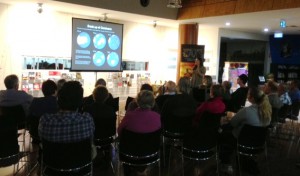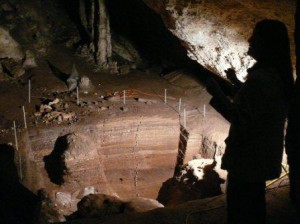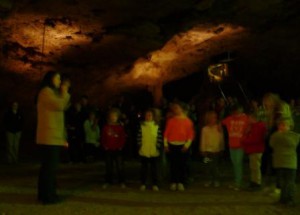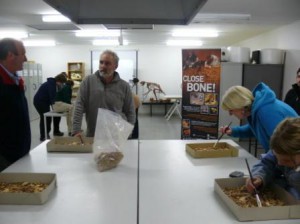Fossil events succeed in helping paint the climate change picture
Did you know that the Naracoorte Caves National Park is the only site on Earth that preserves a continuous fossil record of the past 500,000 years? Its incredible scientific value lies in the fact it has more than 100 fossil sites spanning this time period within the Park’s 26 or so caves.
Sometimes it’s a good idea to look to the past to see where our future lies. Even though some may think climate change is a new phenomenon, according to palaeontologists, it has all happened before. Two recent Up Close events focused on the world class research happening at the Caves, and unearthed some secrets of the past 50,000 years in seeing how plants and wildlife responded to changing climates, and what lessons we can learn for today and the future.

Dr Liz bringing science to the masses and making sense of past climate change at the Mount Gambier Library.
The 25 people who turned out at the Mount Gambier library on Wednesday 10th April were captivated by Dr Liz Reed, Palaeo-ecologist from Flinders University, who not only presented on the amazing work she is leading at the Caves, but made sense of what can sometimes be tricky, mind boggling, scientific concepts (what does climate change mean and look like? how do you measure it?), and unraveled the secrets of how they collect and analyse fossil specimens, find relationships to climate conditions and what it all means.
Liz’s research centres on examining cave fossil deposits and seeing how biodiversity (plants, animals and the way they connect) has responded to climate change during the past 50,000 years. Her work is of particular relevance to understanding and managing biodiversity and conservation, having direct applications to conservation and restoration of the natural environment today.

Dr Liz describing the incredible dig site at Blanche Cave and the world-class research she is leading
As we learnt, piecing the story together is more than just looking at some big old bones that we may associate with the Caves. The little bones can often tell us more about the climate at the time, as too can pollen, scats (poo), snail shells, diatoms (a type of algae), old fossilised regurgitated owl pellets, and lots of other things.

Nearly 70 people-include many children -went into the depths of Blanche Cave to look at the dig site (and discover the local bats!)
A week later on Thursday 18th April almost 70 people, including many families making the most of the school holidays, descended into Blanche Cave at the Naracoorte Caves National Park with Liz and fellow cave and bat expert Steve Bourne to actually see one of the dig sites where this research is happening.
Steve and caves guide Frank took the children off exploring the bowels of the Cave on a special adventure, finding some of Australia’s rarest mammals, the critically endangered Southern Bent-wing Bat, who call the Naracoorte Caves home during the warmer months.
The night ended with a visit to the fossil laboratory, where those that attended could try their hand at sorting through some of the finds Liz and her team have unearthed from the dig sites. What an amazing night! I think everyone who attended learnt so much (I certainly did) and hopefully will understand a little bit more about what a unique treasure the Caves are (and they’re right here in our backyard!) and the role they’re playing on the world stage.
A big thank you to Liz, Steve, Frank, Decima and all the Cave guides, the Friends of Naracoorte Caves volunteers, Deb, and Kristi at the Mt Gambier library.


